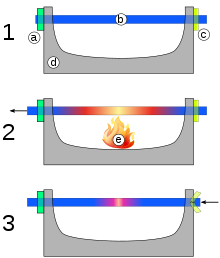Bolt sprinkler
The bolt sprinkler , also known as a contraction apparatus, is a device with which, usually in the context of physics lessons , the phenomenon of the change in length of metallic materials and the forces that occur under the action of heat or cold are demonstrated. It was invented by the Irish physicist John Tyndall in the 19th century and is known in the English-speaking world as Tyndall's bar breaker .
construction
As shown in the picture on the right, the bolt sprinkler essentially consists of the bracket (d), a massive drawbar (b) made of wrought iron , the replaceable bolt (c) and a nut (a). The tie rod is clamped between the bolt and nut.
Test execution
To carry out the experiment, a cast iron bolt is clamped in (phase 1) and the pull rod is heated to red heat with a gas burner (e) (phase 2). During the heating process, the nut is tightened to compensate for the elongation of the tie rod. When the pull rod cools down again (phase 3), the tensile forces are so high that the clamped cast iron bolt tears off impressively with a loud bang or is at least bent.
swell
- ↑ Operating instructions for the bolt explosion test. Retrieved August 13, 2020 .
- ↑ Video of the bolt explosion test. Retrieved August 13, 2020 . ( MPG ; 2.8 MB)
media
- Commons : Bolt Explosion Test - Collection of images, videos and audio files

